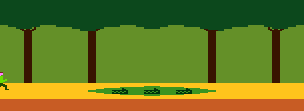Thanks!
I understand - closer to the arcade is why I've been making new ports based on Asteroids and Berzerk. The "just 4 room layouts" of the original 2600 Bezerk was one of the things that always annoyed me (others being just 1 shot for all those robots and that robots were always vertically separated, so explosions couldn't take out other robots). My take creates the 64,000 different rooms using the same technique as the arcade, I go over how that works in this blog entry, as well as corrects those other shortcomings:
Those are some nice boxes! The asteroids one shows a way to get the score plus graphically show the extra ship - use the playfield to draw the score. The score wouldn't look as nice as it does now though.
One thing I didn't cover on my decision to use DPC+ and ARM support. Fred Quimby (batari) used a lot of money to develop the Harmony and Melody boards. The stand-alone Melody boards(used to create single stand-alone games) haven't seen a lot of use yet, so he's not recovered his investment. I'm hoping that Space Rocks, Frantic and Stay Frosty 2 will help him recover his investment in the homebrew community.
Yes, there's a sequel to Stay Frosty under development. We ran into some real-life conflicts that caused it to be delayed. It has new objects, power ups (granting new abilities such as throwing of snowballs), new enemies, etc. It also supports multiple buttons via the Genesis gamepad (can still use a standard Atari joystick).
Main Menu
stayfrosty2.bin_56.jpg
Throwing a snowball
stayfrosty2.bin_30.jpg
I understand - closer to the arcade is why I've been making new ports based on Asteroids and Berzerk. The "just 4 room layouts" of the original 2600 Bezerk was one of the things that always annoyed me (others being just 1 shot for all those robots and that robots were always vertically separated, so explosions couldn't take out other robots). My take creates the 64,000 different rooms using the same technique as the arcade, I go over how that works in this blog entry, as well as corrects those other shortcomings:
Those are some nice boxes! The asteroids one shows a way to get the score plus graphically show the extra ship - use the playfield to draw the score. The score wouldn't look as nice as it does now though.
One thing I didn't cover on my decision to use DPC+ and ARM support. Fred Quimby (batari) used a lot of money to develop the Harmony and Melody boards. The stand-alone Melody boards(used to create single stand-alone games) haven't seen a lot of use yet, so he's not recovered his investment. I'm hoping that Space Rocks, Frantic and Stay Frosty 2 will help him recover his investment in the homebrew community.
Yes, there's a sequel to Stay Frosty under development. We ran into some real-life conflicts that caused it to be delayed. It has new objects, power ups (granting new abilities such as throwing of snowballs), new enemies, etc. It also supports multiple buttons via the Genesis gamepad (can still use a standard Atari joystick).
Main Menu
stayfrosty2.bin_56.jpg
Throwing a snowball
stayfrosty2.bin_30.jpg


 !
! !
! !
!





 )
) ). The JPG looks significantly worse than my original PNG (which you can
). The JPG looks significantly worse than my original PNG (which you can 
Commenta